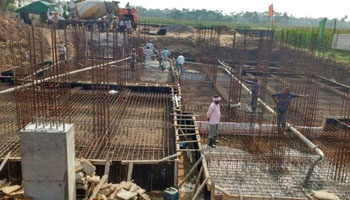You have no items in your shopping cart.
Post Requirement
If you are going to construct a new house, it is essential to know the prime components used in building construction. The knowledge of these materials helps in making smart and budget-friendly decisions. Reinforced Cement Concrete is one of those materials, which is a prime and well-known term in building construction.
What is Reinforced Cement Concrete?
Concrete is a versatile construction material, which is obtained by hardening a mixture of cement, sand, gravel and water in well-proportioned quantities. As we all are aware that, concrete has a very high compressive strength but low in tensile strength. Wherever tensile forces are involved like in slabs and beams, it is recommended not to use plain concrete.
So, adding steel to the concrete is the solution, as we know it has high tensile strength and also possesses good compressive strength. However, the bond between concrete and steel works well and when these two are combined called reinforcement. After the alliance, the material is known as Reinforced Cement Concrete.

Now the material (R.C.C) is capable of withstanding compressive loads, tensile stresses and shear forces upon any structure. It has already proved remarkably useful and reliable in building construction.
Properties of Reinforced Cement Concrete
Reinforced concrete is a structural material, and a good one should meet all the requirements ensuring its quality and sustainability. Here are some of the properties of good R.C.C.
• It should be capable of withstanding compressive, tensile, bending and shear forces.
• It should provide complete insulation against sound and heat.
• Ensure durability to the structure
• The structure built with R.C.C should be able to support any load.
• It should prevent corrosion by providing proper cover to the reinforcement.
• It should develop hair cracks within the permissible limit.
• When it's fresh, a good R.C.C can be moulded to the desired shape and size.
• It should provide adequate control over the cross-sectional requirements.
Advantages of Reinforced Cement Concrete
Structures made from reinforced concrete are stable and durable. It possesses high compressive and high tensile strengths. It is economical, and the maintenance cost is almost ignorable. R.C.C has the least chances of buckling and rusting. It has resistance to fire and other climatic changes.
R.C.C structures are aesthetically up to the mark and do not require cladding. The material is available everywhere around the world and does not require expertise for working on it; normal skilled labour can also work with it.
Uses of Reinforced Cement Concrete
R.C.C is widely used construction material from foundations to the rooftops of the building. Some of its chief uses are listed below:

• It is used as a structural element in beams, columns, footings, lintels, stairs, roofs and slabs.
• It is used for pre-casting railway sleepers and electric poles.
• It is used for paving in airports, roads and high traffic areas.
• It is used for constructing various structures like water tanks, dams, bins, silos, bunkers, bridges, retaining walls, underwater structures, towers, multi-storey buildings, docks and harbours.
R.C.C is the most used building material for almost all types of structures and is also used in atomic plants to prevent danger from radiations emitting from it.
Now you know the importance of reinforcement in construction. Don't forget to check out: Types of Steel Reinforcement in Construction.
Technically Reviewed by Rajesh Pagadala, MS, Founder & CEO - BuildersMart. Written by Vani paspula, Content Manager.
Vani Paspula














SUNIL GEORGE
posted on Sep 7, 2021 11:04:40 AM